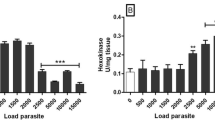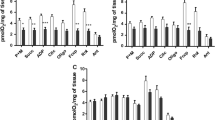Abstract
In parasitic nematodes the rate-limiting step in the polyamine interconversion pathway is catalysed by polyamine oxidase. MDL 72527, the specific inhibitor of mammalian polyamine oxidase, had no effect on the Ascaris suum enzyme, whereas its activity was inhibited in a time-dependent manner by the haloallylamine MDL 72145, originally designed as a specific inhibitor of monoamine oxidase A and B. The dissociation constant (K i) was found to be 0.9 μM and the enzyme half-life under saturation conditions (t 50) was determined to be 0.8 min. Incubation of A. suum in vitro in the presence of 50 μM MDL 72145 for 6 h resulted in a decrease in polyamine oxidase activity to about 20% of the control value, and spermine concentrations simultaneously increased about 200%. Both results suggest that MDL 72145 might be a chemical lead compound for the design of new chemotherapeutic agents against nematode infections.
Similar content being viewed by others
Author information
Authors and Affiliations
Additional information
Received: 15 November 1995 / Accepted: 15 January 1996
Rights and permissions
About this article
Cite this article
Müller, S., Hunter, K. & Walter, R. Effect of haloallylamines on polyamine oxidase activity and spermine levels in Ascaris suum . Parasitol Res 82, 571–573 (1996). https://doi.org/10.1007/s004360050165
Issue Date:
DOI: https://doi.org/10.1007/s004360050165




